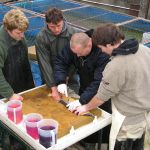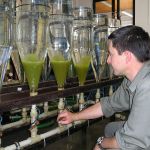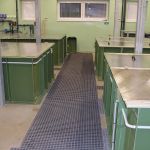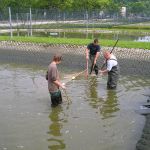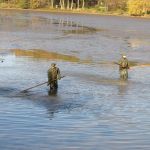
Research Institute of fish Culture and Hydrobiology /RIFCH/
The Research Institute was established in Prague in 1921. In 1953 it was moved to the town of Vodňany in South Bohemia. Since 1996 it has been part of the University of South Bohemia in České Budějovice.
About Genetic Fisheries Center
The purpose of the Genetic Fisheries Centre (GFC) is to preserve genetic resources VUZV of existing broodstock and populations of carp, tench, wels and sturgeons. Nowadays we are keeping 15 breeds and lines of common carp, 11 breeds plus three colour (golden, blue and white) varieties of tench and two breeds of wels. This Centre has been entrusted with leading the breeding and testing program of common carp and tench performance in the Czech Republic since 1982.
We take pride in successful breeding of several species of the Chondrostei order. We bought immature Russian sturgeon (Acipenser gueldenstaedtii) in 2001 and Siberian sturgeon (Acipenser baerii) in 2002. Sterlet (Acipenser ruthenus), Sevriuga (Acipenser stellatus) and Beluga (Huso huso) were bought in 2003.
We arranged two CITES permits for import of fertilized eggs of Mississippi paddlefish (Polyodon spathula) from private aquaculture farm in Kentucky, USA in 2005 and 2007. Atlantic sturgeon (Acipenser oxyrinchus), albinotic sterlet and Shortnose sturgeon (Acipenser brevirostrum) (CITES I) branched our Centre in 2009.
The GFC also provides a functional basis for laboratories of the faculty dealing with e.g. study of colour heritability of tench, genome manipulations of selected fish species (common carp, tench, gibel carp, sturgeons – see Laboratory of molecular, cellular and quantitative genetics), fish gametes (see Laboratory of reproductive physiology) and for subsequent application of obtained results in aquaculture. We successfully collaborate with other laboratories of our faculty, of course.
This Centre has also been serving since 1996 for education of fish breeding for faculty Bachelor, Master and Ph.D. students in form of field training and practise.
The GFC also provides a functional basis for laboratories of the faculty dealing with e.g. study of colour heritability of tench, genome manipulations of selected fish species (common carp, tench, gibel carp, sturgeons – see Laboratory of molecular, cellular and quantitative genetics), fish gametes (see Laboratory of reproductive physiology) and for subsequent application of obtained results in aquaculture. We successfully collaborate with other laboratories of our faculty, of course.
This Centre has also been serving since 1996 for education of fish breeding for faculty Bachelor, Master and Ph.D. students in form of field training and practise.
The GFC is involved in international scientific collaboration AQUAEXCEL (Aquaculture Infrastructures for Excellence in European Fish Research) http://www.frov.jcu.cz/images/stories/AQUAEXCEL%20factsheet_FINALv1%20(May%202011)(1).pdf and into national projects supported by Czech administration (http://www.frov.jcu.cz/cs/projekty-na-fakulte/projekty-na-fakulte).
The GFC has a modern and multi-purpose equipped fish seasonal hatchery (the hatchery itself with possibility of farming early fish stages, indoor tanks for preparation of broodstock for controlled reproduction, experimental rearing in special troughs and for work with young brood fish) with total area of 220 m2. The tap water from pipeline is used for egg incubation and fry nursing. These two recirculation systems through biofilters are cleaned and sterilized by ozonizer and UV radiation. Water for broodstock, egg incubation and fry nursing is heated to required temperature in three mutually independent reservoirs. Water levels, water temperatures and oxygen saturation with control of preparation of technological flowing-through or recirculated water are monitored in the entire system with the use of technological reporting by means of GSM technology.
Since 2013 we carry on a new facility with year-round operation. There are laboratories, sanitary and technological background. The lecture room for 16 students or visitors is fully equipped.
The experimental part is equipped with a special research laboratory for incubation of fertilized fish eggs in small quantities under fully controlled conditions.
The hatchery with ten Weis incubation jars and eight hatching troughs is ready for experiments with higher quantity of fish eggs. Twelve circular tanks (6m3 in total) and four rectangular basins (12m3 in total) operated by two separated recirculation aquaculture systems (RAS) are used for rearing the yearlings.
Two RAS (2 x 8m3) are ready for experimental preparation of broodstock for controlled reproduction.
The hatchery with ten Weis incubation jars and eight hatching troughs is ready for experiments with higher quantity of fish eggs. Twelve circular tanks (6m3 in total) and four rectangular basins (12m3 in total) operated by two separated recirculation aquaculture systems (RAS) are used for rearing the yearlings.
Two RAS (2 x 8m3) are ready for experimental preparation of broodstock for controlled reproduction.
We arranged two CITES permits for import of fertilized eggs of Mississippi paddlefish (Polyodon spathula) from private aquaculture farm in Kentucky, USA in 2005 and 2007. Atlantic sturgeon (Acipenser oxyrinchus), albinotic sterlet and Shortnose sturgeon (Acipenser brevirostrum) (CITES I) branched our Centre in 2009.
The GFC also provides a functional basis for laboratories of the faculty dealing with e.g. study of colour heritability of tench, genome manipulations of selected fish species (common carp, tench, gibel carp, sturgeons – see Laboratory of molecular, cellular and quantitative genetics), fish gametes (see Laboratory of reproductive physiology) and for subsequent application of obtained results in aquaculture. We successfully collaborate with other laboratories of our faculty, of course.
This Centre has also been serving since 1996 for education of fish breeding for faculty Bachelor, Master and Ph.D. students in form of field training and practise.
The GFC also provides a functional basis for laboratories of the faculty dealing with e.g. study of colour heritability of tench, genome manipulations of selected fish species (common carp, tench, gibel carp, sturgeons – see Laboratory of molecular, cellular and quantitative genetics), fish gametes (see Laboratory of reproductive physiology) and for subsequent application of obtained results in aquaculture. We successfully collaborate with other laboratories of our faculty, of course.
This Centre has also been serving since 1996 for education of fish breeding for faculty Bachelor, Master and Ph.D. students in form of field training and practise.
The GFC is involved in international scientific collaboration AQUAEXCEL (Aquaculture Infrastructures for Excellence in European Fish Research) and into national projects supported by Czech administration.
The GFC has outdoor breeding tanks with either through-flow or recirculation system.
The systems of earthern ponds with total acreage of 43 ha serve for rearing of young, marketable and brood fish.
Staff and contacts





